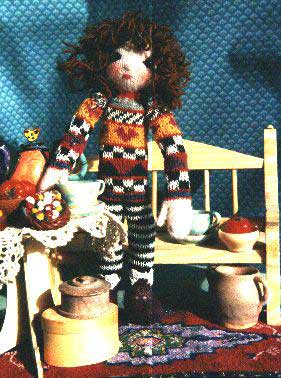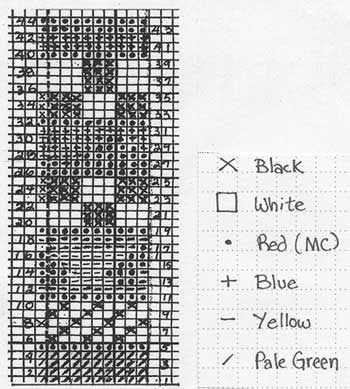 By Noreen Crone-Findlay
By Noreen Crone-Findlay
There's a good chance you have seen a doll created by this talented fiber artist Noreen Crone-Findley. She's the author of Soul Mate Dolls: Dollmaking as a Healing Art, published by Krause, and her designs have appeared in Vogue Knitting, Great America Crafts, Canadian Living and many other magazines. She also taught classes at Crochet Renaissance this past fall.
What motivates Noreen? In her words: "I am the author of "Soul Mate Dolls: Dollmaking as a Healing Art". I'm also a wife; mother of a daughter and a son; a designer; a doll artist; a workshop facilitator and a professional puppeteer (I perform approximately 250 shows a year to young children, hopefully inspiring them to take good care of the Earth).
"I really love playing with fiber. I enjoy using unusual techniques, such as weaving, crochet, knitting, embroidery and paper shaping in my dollmaking. I believe that the art of dollmaking is a wonderful way to open doorways to creativity, healing and wholeness. I am passionate about knitting, crochet and small loom weaving, and am always working on new designs that will inspire my readers and workshop participants to pick up their hooks, needles and small loom!
"I hope that my designs will bring you pleasure and delight. I wish you all good things, in all ways!"
http://dollmakersjourney.com/noreen.html
http://www.artisansnet.net/njd/fall/noreen.html
Elspeth©
Elspeth is worked in stockinette stitch (knit on the odd-numbered rows and purled on the even numbered rows). Elspeth's sweater is worked in Fairisle knitting, which means there is more than one yarn color in a row. The sweater pattern is charted, which means there is a graph (each square of the graph represents one stitch). In each square is a symbol telling the color in which that stitch is worked. You carry the unworked yarn behind the stitches, on the wrong side. Feel free to work the doll in your own color choices.
Tips on Reading a Graph
When you are reading a chart, you begin at the lower edge. Cover Row 2 with a strip of card stock while you are knitting Row 1. As you work each row, slide the strip of cardboard up, revealing only the row on which you are currently working.
Read odd numbered rows on the chart from right to left, and even-numbered rows from left to right. After you finish a row, it is a really good idea to use a row counter to keep track of where you are in the chart. By counting rows, you will know exactly where you are in the pattern, even if you have to stop knitting.
Finished Doll Size
The finished size of the doll is determined by the size of the knitting needles and thickness of the yarn that you use. Noreen has provided several options below and it is possible to substitute other yarns and threads. Remember to check the gauge of whatever yarn you are using.
If you use Patons "Décor" and size 7 (4 mm) knitting needles, Elspeth will be approximately 20" tall.
If you use Patons "Country Garden" or Naturally "Magic Garden Buttons" and size 5 (3.75 mm) needles, she will be approximately 15" tall.
If you use size 1 needles (2.25 mm) and pearl, embroidery or crochet cotton, Elspeth will be about 10" tall.
ABBREVIATIONS USED IN THE PATTERN:
K = knit
P = purl
K2tog = knit two stitches together as one stitch to decrease
Dec = decrease
Inc = increase
St st = stockinette stitch
R = row
NOTE: The head and body are knitted as a unit, and the arms and legs are knitted separately, then sewn on after the knitting is completed.
MATERIALS:
You will be able to make several dolls from these quantities, as only small amounts of each color are used:
Patons Décor - One skein each of the following colors:
Main color (MC): #1657 Claret
#1603 Black
#1601 White
#1715 Mallard
#1636 Sage Green
#1710 Maize
Boots: #1627 Rich Aubergine
Skin tone: #16590 Pale Bone or #1631 Taupe or #1633 Chocolate Taupe
Hair color: Your choice
or
Nautrally Magic Garden Buttons - One skein each of the following colors:
Main color (MC): #875 Red
#882 Black Magic
#870 White
#876 Cobalt
#873 Watersprite
#877 Yellow
Boots: #881 Purple
Skin tone: Magic Garden Classic #868 Cream
Hair color: Your choice
or
Patons Country Garden (DK -double worsted weight yarn)
One skein each of the following colors:
Main color (MC) - #22 Brick Red
#64 Black
#01 Snowdrop
#29 Lapis
#34 Mist Blue
#07 Primrose
Boots: #28 Wild Violet
Skin Tone: #45 bisque or #46 Ginger or #50 Potato Skin
Hair color: Your choice (doll is shown with #50 Potato Skin)
or
Small amounts of the following colors of
Crochet cotton or weaving cotton (2/8 weight): white, black, pale green, blue, red, yellow, lavender
Baby yarn-flesh color
Fine yarn - hair color of your choice
Black beads or dome style buttons for eyes ( 6mm for smallest version, 11 mm for larger doll)
OTHER MATERIALS:
Stuffing
Needles in the appropriate size for your yarn
Yarn needle (blunt-edge for sewing)
Crochet hook for applying hair
Sewing needle to sew on beads
Row counter
Row marker to assist in reading the chart
GAUGE
Patons Décor:
8 stitches and 13 rows = 2"
Patons Country Garden DK:
12 stitches and 16 rows = 2"
Naturally Magic Garden Buttons:
13 stitches and 16 rows = 2"
Embroidery floss and size O/2.25 mm needle:
16 stitches and 22 rows = 2"
ABBREVIATIONS
K = Knit
P = Purl
St(s) = stitch(es)
St st = Stockinette Stitch
K2tog = knit two stitches together
MC = Main color
DIRECTIONS
HEAD
Using flesh color, cast on 10 sts.
Row 1: K
Row 2 & 4: P
Row 3: (k 1, p 1 in same st) in each st across (20 sts)
Row 5: Repeat row 3 (40 sts)
Row 6-30: Work in St st
Row 31: K2tog across row (20 sts)
Row 32: P
Row 33: K2tog across row (10 sts)
NECK
Using red (MC)
Row 1-4: Work in St st.
BODY
Row 1: (k1, p 1 in same st) in each st across (20 sts).
Row 2: P
Row 3: Repeat row 1 (40 sts)
Row 4-44: Follow chart, repeating chart 4 times across for Elspeth's body. Cast off.
LEGS
Cast on 18 sts.
Work 30 rows, alternating 2 rows of white, 2 rows black, then change to Boot color.
BOOT
Row 31-42: St st
Row 43: K 6, (k 1, p 1, k 1 in next st) 6 times, k (30 sts).
Row 44: P
Row 45: K 12, (k 1, p 1, k 1 in next st) 6 times, k 12 (42 sts)
Row 46-54: St st
Row 55: K2tog across (21 sts).
Row 56: P
Row 57: K2tog across, k 1 (11 sts)
Row 58: P
Row 59: Cast off.
ARMS
Follow chart (repeat 2 times across)
Row 1: Cast on 10 st and knit across.
Row 2: P
Row 3: (k 1, p 1) in each st across (20 sts).
Row 4-38: St st.
HAND
Using flesh color:
Row 39-42: St st
THUMB
Rows:43: K 3, turn. Work 5 rows St st on these 3 sts.
Next Row: K3tog, break yarn, draw through st.
Row 44: Rejoin yarn and k across remaining sts.
Row 45-52: St st.
Row 53: K2tog across to last st, k 1.
Row 54: P, then break yarn, draw through all sts, draw up.
FINISHING
Sew center back seam. Stuff. Stitch to lower edge of Body. Embroider shoe laces by threading a darning needle with the shoelace color, and stitching a zigzag pattern as if you were lacing a shoe. Stitch seams in arm and thumb. Stuff. Sew to body.
Sewing Seams with the Baseball Stitches:
The Baseball stitch is a good choice for joining edges. Hold the two pieces with their wrong sides together. Starting at the right hand side, you will be making a "v" shaped stitch. Bring the needle up from the gap to the outside of one side, go back down into the gap, up and out the other side.
FACE
How to place the features.
- Sew the eyes at the horizontal midline of the face.
- The ears also go at the midline (Think of how useful ears are for holding up your glasses!).
- If you drew an imaginary line halfway between the chin and the eye line, you would have the perfect placement for the nose. Now, another imaginary line halfway between the nose line and the chin, and you have the perfect place for the mouth.
- When embroidering the features and sewing on the eyes, remember to anchor the thread at the back of the head. Firmly sew on appropriate size eyes, at the imaginary eye line.
- The nose and ears are made by holding the knitting needle against the head, horizontally for the nose, and vertically for the ears. Bring the flesh colored yarn up through the head, and stitch over and over the knitting needle, then take the darning needle out the back of the head and anchor the yarn by stitching in place several times. Pull the knitting needle out of the stitches. Embroider the mouth with dark pink embroidery floss, referring to the photograph.

HAIR
Lightly wrap yarn around 4 fingers. Snip end from ball. Slip the scissors into the loops of yarn. Snip the loops once to give you the lengths of hair. To attach them to her head, fold them in half to form a loop. With a crochet hook, pull this loop through a stitch on her head. Pull the ends through the loop. Continue until she has a full head of hair. To make bangs, wrap the yarn around just 2 fingers and use the shorter lengths of yarn across her forehead.
OPTIONAL
You may chose to sew a small piece of lace around the top of each boot.
Elspeth© is an original, copyrighted design. It is reproduced by the Craft Yarn Council of America at its web site by permission from designer Noreen Crone-Findlay.
Every effort has been made to ensure the accuracy and completeness of these instructions. We cannot be responsible, however, for variances in individual techniques, human errors or typographical mistakes.
©2000 Craft Yarn Council of America
